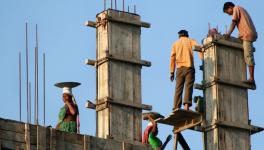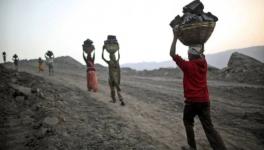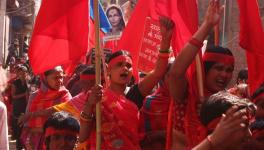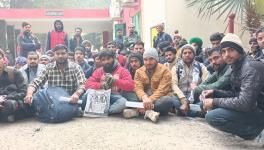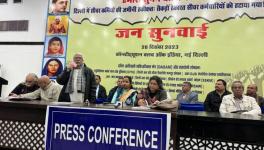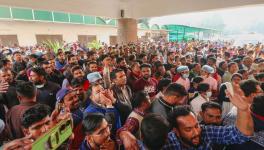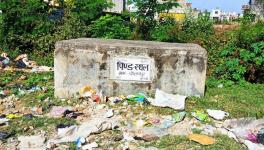Journey to Hell
Thousands of migrant labourers travel to metropolitan cities all around the year searching for work due to pathetic conditions back home. Akhlas Ahmad met some of them in Delhi.
This article is part of the series of select news features and articles of students from AJK MCRC , Jamia Milia Islamia University being hosted by Newsclick.
When Shamima, 24, got married to Shamim four months ago, there were stars in her eyes. As she was busy with household chores in 24 Parganas district in West Bengal, she kept imagining of the wonderful future that she might be blessed with after moving to Delhi where her husband worked. She also thought of how she would not live in poverty like she did with her parents. Four weeks after her marriage, she was brought to Delhi and immediately had to work for 14 hours a day at construction sites as that was the only way to keep her kitchen fires burning. Her husband also was a daily wage labourer searching for work everyday. “My dreams have gone awry,” she said tearfully, “as this is not I thought marriage was all about.”
Migration in India has been happening all through history but its significance got raised post neo-liberal globalization. Migration of the poor seeking employment is mostly from the underdeveloped states like Bihar, Bengal, Chhattisgarh, Orissa and Uttar Pradesh the metropolitan cities of Delhi and Mumbai. It has accelerated during the last few decades. One of the major reasons is that there are fewer opportunities in their states. Ram Babu Bhagat, Professor at the Department of Migration and Urban Studies at International Institutes for Population Sciences in Mumbai, points out, “Uneven development is the main cause of migration from rural areas to urban India.”
75 -year old Suleman, a resident of Katihar district from Bihar, says, “I came to Delhi five years ago for employment and started pulling a cycle rickshaw. I have five daughters whom I have to get married and I am now suffering from asthma.Most of my expenses are on my medication. How
is it possible for me to satisfy dowry demands of the society? Ab toh Allah hi hafiz hai!” (Only God can take care of me now)
The total migration index as per the census of 1971 was 167 million persons, which has gone up to 315 million in 2001. Why has the migration index gained momentum in the last few years? Prof. R. B. Bhagat says that the population of India was increasing rapidly and the lack of job opportunities leads the migrant labourers to advanced cities like Delhi. “NREGA and similar government schemes have failed and are far from the ground reality due to rampant corruption. This is why labourers migrate to places where they get better wages,” he says.
It is estimated that the present strength of interstate migrants is around 80 million of which 40 million are in construction industries and 20 million are domestic workers, 2 million are sex workers, while five million work as call girls. According to a study conducted by an organization called Social Alert, 92 percent of the domestic workers are women, girls and children and 20 percent of these females are under 14 years of age. A disturbing aspect of this story is that when these migrants do not get employment, they end up being victims of sexual abuse.
The construction sector is the second largest provider of employment after the agriculture sector. Most of the employment in construction is migrant labour. The working hours are from sunrise to sunset and working hours of women is fourteen to sixteen hours. Women are paid Rs. 175-250 a day while men are paid Rs. 250-300 a day. Meeting daily expenses is a daily struggle. Alimunnisa, a 55 year old widow coming from Katihar in Bihar says, “Price rise has increased and life has become hell.”
The workplaces are also unsafe. The workers have no social security, compensation for injuries, access to drinking water and health care. It is a sad truth that India has the world’s largest accident rate among workers.
Pathetic pay and a very sorry state of living conditions is the only reality for these migrants. These migrant workers also do not possess public distribution cards (PDC) and thus are forced to buy food grains at higher market prices. Women are often subjected to gender discrimination.
As far as the legal provision for migrant labourers is concerned, the Government of India made an enactment in 1979 called the Interstate Migrant Workmen Regulation of Employment and Condition of Service Act 1979. Though the Act covers only interstate migrants, it lays down that contractor must pay timely wages equal or higher than the minimum wage, provides suitable residential accommodation, give prescribed medical facilities and so on. The Act sets penalties including imprisonment for non compliance. Points out Prof. Bhagat, “Needless to say, the Act has remained only on the paper. The migrants face additional problems as they are both labourers and migrants. By merely making the law, the problem of the labourers cannot be sorted out. Active execution of the law is the solution to problems.”
Disclaimer: The views expressed here are the author's personal views, and do not necessarily represent the views of Newsclick.
Get the latest reports & analysis with people's perspective on Protests, movements & deep analytical videos, discussions of the current affairs in your Telegram app. Subscribe to NewsClick's Telegram channel & get Real-Time updates on stories, as they get published on our website.









